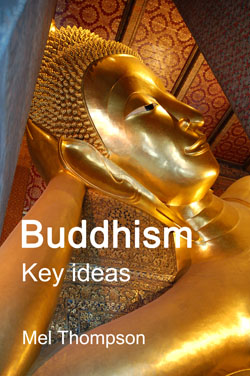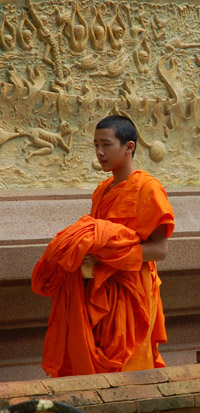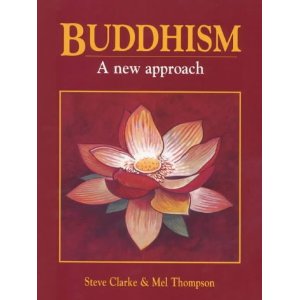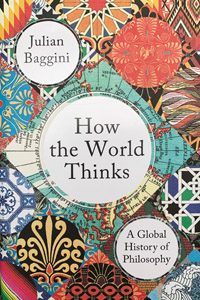 'With its blending of wisdom and compassion, Buddhism offers a view of the world that has transformed the lives of millions of individuals over the last two and a half thousand years.
'With its blending of wisdom and compassion, Buddhism offers a view of the world that has transformed the lives of millions of individuals over the last two and a half thousand years.
Its ideas are not presented as having inflexible religious authority, nor simply as an intellectual challenge, but as an invitation to reflect on the nature of reality and on the universal human quest for happiness in a world where everything is changing and nothing is secure.'
(from the introduction to Buddhism: Key Ideas)
 Buddhism: key ideas
Buddhism: key ideas
From Abhidhamma to Zen, this book offers a simple introduction to key Buddhist ideas - each explained in straightforward language.
Each idea is linked to others, so you can start with any one entry - the Buddha, perhaps, or Meditation or Zen - and follow the links to related topics, building up a complete picture of the key ideas of Buddhism.
It is ideal for anyone wanting to get a systematic grasp of Buddhist thought and for students looking either for a quick introduction to its ideas, or revising for examinations. The language is accessible and suitable for students at GCSE and above.
I have self-published this book as cheaply as possible. It replaces my earlier title 101 Key Ideas: Buddhism, which was published by Hodder Education in 2000, as part of their 101 Key Ideas series.
Available in Kindle format for only £1.99 / $2.99!
'I was having trouble getting my head round many aspects of my Buddhism A-Level but as soon as I read this book it all became clear. It is a match between a dictionary and a text book, it only tells you the things you really need to know. I could not reccommend it enough to anyone who is either studying the subject or thinking of becoming a Buddhist.'
(from a review of the original book on Amazon)

Young men in northern Thailand, towards the end of their time spent as monks during the Rains Retreat.
 Buddhism and philosophical speculation (an extract from Eastern Philosophy)
Buddhism and philosophical speculation (an extract from Eastern Philosophy)
Buddhism is certainly not against philosophy. At it peak, before being destroyed in the Muslim invasions of northern India, the Buddhist University of Nalanda had some three thousand scholars drawn from all over India and also from China, Korea, Tibet, Mongolia, Sri Lanka and Sumatra. Systematic study was at the heart of Buddhist training, and Nalanda offered courses in grammar and philology, medicine, logic, the fine arts and metaphysics.
On the other hand, the Buddha was concerned to distinguish between things that could be examined profitably and those metaphysical questions that would never be resolved and which might prove to be no more than a distraction. Questions the Buddha refused to answer include:
- whether the world is finite or eternal
- whether the enlightened person does or does not exist after death.
Now this might seem a major oversight, especially since we are looking at the Buddhist contribution to Eastern Philosophy. On closer inspection, the matter becomes clearer. What the Buddha was refusing to do was to take sides in contemporary philosophical debate. One reason for this may well have been that all such debate depends on the acceptance of key terms and concepts, and by refusing to enter into metaphysical debate he was emphasising the inadequacy of existing concepts. As in many areas, the Buddha sought to take a middle path. To have said that the world as eternal would have been inadequate to the point of being wrong. On the other hand to say that it was not eternal would have been equally misleading. He therefore affirms a 'neither this, neither that' approach and refuses to give an answer that could subsequently be misunderstood.
More importantly, however, by denying the validity of such questions, and by insisting that his sole aim was to resolve the problem of human suffering, he effectively makes speculation for its own sake a sideline, emphasising the place of the problem of suffering and the means of overcoming it at the heart of the philosophical quest.
In one of the collections of early sutras (The Majjhima Nikaya), the Buddha says that any idea of ‘I am this’ is a conceiving, or ‘I shall be formless’ is a conceiving. He wants none of this speculation and declared:
‘… conceiving is a disease, conceiving is a tumour, conceiving is a dart.’ (MN 140)
and that, by overcoming all such conceiving one may become ‘a sage at peace’.
Those who who concentrate on the cultural or religious artefacts of Buddhism - the temples, monks and images - may miss the very radical nature of the Buddhist view of reality. It is a view which cannot be encapsulated in conceptual terms alone. But above all else, it is a view of the world as dynamic, as a process of interconnecting relationships and conditions.
A Western comment...
For a Western thinker – schooled since Descartes with the idea that ‘I think, therefore I am’, and thus the self as an indubitable fixed point, or since Aquinas in the idea of God as an unmoved mover, uncaused cause, source of all values, the intelligent and purposeful designer – these twin certainties of much traditional western metaphysics are removed by Buddhism. In their place is an ever-changing reality which is only known in its immediacy and through participation, never captured conceptually.
For Western philosophy that takes this element of change and process seriously, one might look at Heraclitus among the ancients. Among modern philosophers, process has been a major theme of H. Bergson and A. N. Whitehead.
 For all these years, my certain Zen:
For all these years, my certain Zen:
neither I nor the world exist.
The sutras neat within the box,
my cane hooked upon the wall,
I lie at peace in moonlight
or, hearing water splashing on the rock,
sit up: none can purchase pleasure such as this:
spangled across the step-moss, a million coins.
Shutaku (1308 - 1388)
Translation: Lucien Stryk and Takashi Ikemoto, in The Penguin Book of Zen Poetry.
 A pragmatic philosophy... (another extract from Eastern Philosophy)
A pragmatic philosophy... (another extract from Eastern Philosophy)
If Buddhism were simply a philosophy, the term used for it would be darsana (meaning ‘view’ or ‘direct vision’ and used of all the major Indian philosophies). In fact, another term is used – yana, ‘vehicle’. Buddhism is therefore seen as a spiritual vehicle, a means of making progress. Those things that do not contribute to the liberation of human beings from suffering and ignorance may be ignored as irrelevant.
The Mahaparinibbana Sutta contains a list of essential teachings, believed to have been given by the Buddha, shortly before his death, to his cousin and companion Ananda. The list contains seven key features, broken down into what are known as the ‘37 Aids to Enlightenment’. It is interesting that this summary contains no speculative propositions of any kind. It includes the cultivation of awareness of body, feeling, mental states and objects of thought, moving on to describe the right efforts required, spiritual faculties and powers to be explored, even enlightenment factors including mindfulness, awareness of Dharma, enthusiastic effort, rapture, serenity, concentration and equanimity. It also includes the Eightfold Path, described above.
Such a summary should come as no surprise, since pratitya samutpada (interconnectedness) - which is the key concept at the very heart of the whole of Buddhist philosophy - points out that all things arise in dependence upon conditions. What the Buddha set out in his summary of teachings was the set of spiritual parameters which aimed to help individuals to create the conditions which would allow them to become enlightened.
A Western comment...
In scientific research, the observer and method of observation may influence the conclusions reached. So, for example, in psychoanalysis the analyst is trained to recognise and eliminate the influence of his or her own prejudices. In other words, there is a recognition of the connection between conditions, method and conclusions. Only if the former is acknowledged and taken into account can the latter is to be assessed correctly.
In Postmodernism, the material, the medium and the method of artistic creation are the object of attention. One cannot pretend that there is some abstract ‘reality’ to be communicated which is external to and independent of the vehicle of its communication.
By emphasising the conditions required for insight, rather than simply stating its conceptual content, Buddhism acknowledges the interconnection between methods and results.
In a traditional Buddhist formulation, the Ti Ratana Vandana (Salutation to the Three Jewels), the Buddha’s teaching is described as:
Sanditthiko akaliko ehipassiko opanayiko paccatam veditabbo vinnuiti.
Which may be translated as:
Immediately obvious; always available; something to be examined by trying it out; progressive; to be understood individually by those who are wise.
In other words, Buddhist philosophy claims to be an undogmatic, rational and pragmatic approach to understanding reality.
 Offering incense; Hong Kong.
Offering incense; Hong Kong.








